Format Conversion: A
Project for Those Dreary, Wet Days You Rather Spend
Indoors
by
Bjørn Rørslett |
|
| |
|
In a situation where
rain is pouring down, a nature photographer needs any excuse,
plausible or not, for staying indoors. Constructing your own
optical devices is a fail-safe way of avoiding the wrath of the
weather Gods. This time, I outline an alternate approach to
getting a lens for dramatic and steep perspectives: Do a format
conversion of a cine lens to make it work with your DSLR. Sounds
difficult? Not really. Just read on to learn more about the
ultimate DIY project for photographers.
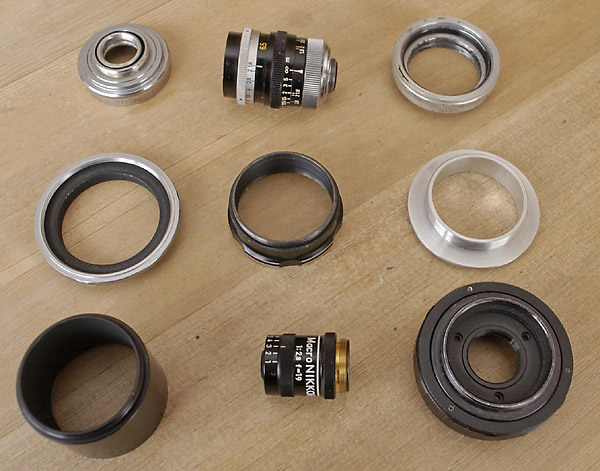
Roll
Your Own Lens
©
Bjørn Rørslett/NN
|
| In order to get the
conversion project going, I have gathered here an
assemblage of useful items from my odds-and-ends drawers.
The crucial parts are the Canon 6.5mm f/1.8 cine lens
(upper row) and a lens for projecting the intermediate
image from the cine lens onto the imager of the DSLR.
I've used an elusive 19 mm f/2.8 Macro-Nikkor in this
case, but a reversed 20 mm would do just fine. The remaining items are a
homemade "D" mount to 39 mm adapter, a Pentax
screw-mount focusing extension ring, a K3 ring to provide
an "F" bayonet for my camera, and various
extension tubes with 39 or 42 mm threads, all of which
have been scavenged from garage sales, used equipment
bins at photostores or what have you. I never throw away
anything that might prove useful later on.
|
Cine lenses for the small 8mm
format can easily be picked up for next to nothing these days.
That format as such is long dead, but the lenses might exhibit
interesting features even today. Why is this? Surely they are so
short in their focal lengths that they cannot possibly focus on a
SLR? Yes, and no. It all depends on your commitment to the task
at hand.
The very advantages with these
lenses are in fact their very short focal length, and the general
high optical quality of many of these designs. Using a
short-focal lens means you can get your subject very close to the
lens, thus providing a steep and dramatic perspective of your
shot. Remember perspective is about the position of your lens
with respect to the subject, not about the angle of view of the
taking lens. Getting closer means getting a more exaggrerated as
thus steeper perspective compared to the normal perception given
by our eyes (and brain).
So, a supershort focal length
allows for a very steep perspective. "All" that remains
is getting that short lens to focus in a useful fashion for your
camera, and that implies attaining infinity focus with it as
well. To this end, an additional - intermediate - lens must be included in the optical pathway,
otherwise the setup will fail.
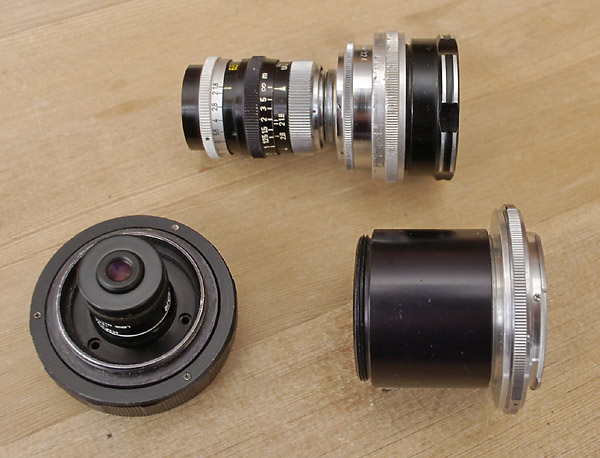
|
Almost There
© Bjørn Rørslett/NN
|
| Shown
here is the format-converted 6.5 mm Canon lens assembled
into fewer and more recognizable modules. Top to bottom depict as
follows; the 6.5 mm Canon lens mounted onto a 39-42 mm
thread adapter, the intermediate lens (a 19 mm
Macro-Nikkor) in its focusing stage made from a Pentax
focusing tube, with 42 mm thread, and a rear tube with 42
mm thread in front and a 42 - 52mm thread to provide a
mounting point for an "F" adapter to the rear.
|
The critical item in the project
is the intermediate lens. This optic has the dual task of making
the front lens focus properly, besides its rôle as a projection
lens to relay the image from the first lens onto the final imager
in the camera. Since the image circle emanating from the cine
lens is smaller than that needed by the camera, additional image
magnification is called for. There is also a need for getting
sufficient space between the front lens and the camera, otherwise
you cannot hope to get infinity focus when the reflex mirror sits
in the optical pathway. Obvious, when the rear flange to film
distance of the cine lens is just a few millimeters, something
other than ordinary extension is called for. A relay lens is the
answer.
During the years I have made
relaying optics by several different approaches. The easy one is
reversing a wide-angle lens on a bellows unit to give the needed
magnification of the intermediate image. Depending on the
magnification you need, lenses from 35 to 20 mm are appropriate.
Even better suited are lenses made for photomacrographic work,
the so-called (true) "macro" lenses. Such lenses are,
or rather were, produced by Zeiss (Luminar), Leitz (Photar),
Nikon (Macro-Nikkor), and other companies supplying
optical gear to scientific labs. If you can find, or afford, any
of these lenses, they are really outstanding for the task at
hand. In my 6.5 mm lens project, I have used various lenses
during the evolution from a prototype (built some years ago) to
the current Mk.II depicted here. I initially used a 24 mm Nikkor
reversed, then a 20 mm Zuiko lens, to end up using a 19 mm
Macro-Nikkor. This shows there is no solution set in stone for
format conversion projects. Any spare lens which is available and
works, will do just fine.
In whatever fashion the
intermediate image is magnified and relayed to its final
destination, you have to accept that it ends up being seen
upside-down. Or rather, the image arrives correctly oriented at
the camera, but camera viewfinders are designed to turn the
incoming image upside-down to make it look "normal", so
in the end the image is right but wrongly displayed. Magnifying
the image means getting a less effective speed of the lens array.
The viewfinder tends to get dark and you often need some
additional lighting of the subject in order to focus accurately.
All of this is just something you have to accept and for old
hands hardened from experience with view cameras, yesterday's
news anyway.
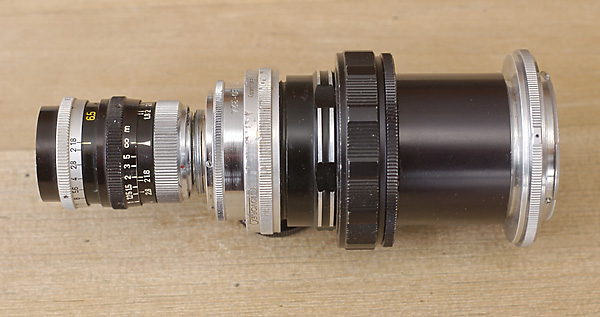
|
The Assembled Lens Array
© Bjørn Rørslett/NN
Small, light-weight,
and very special. Just the way I like my gear (sometimes)
|
| |
|
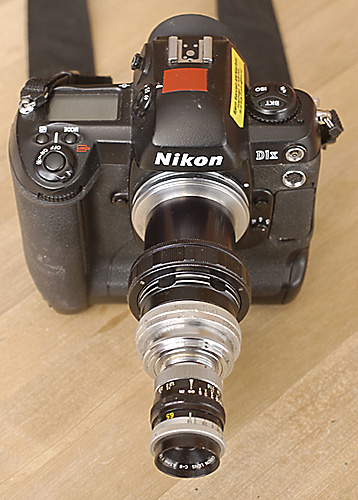
|
Move It
© Bjørn Rørslett/NN
|
| The 6.5
mm Canon lens mounted on my trustworthy D1X camera. |
I recently added another cine lens
to my collection, namely, a 10 mm f/1.8 Cine-Nikkor. This Nikkor
was converted using a 25 mm f/3.5 Zeiss Luminar as the
intermediate optic. At the time of writing I haven't used this
setup sufficiently to ascertain its qualities, but this will
occur in due time.
To what end?
So, you end up with an optical
contraption all of your own, but to what use should this strange
optic be put? Don't let the short focal length fool you into
thinking you'll get a superwide view of the world. This is not
what you get and hardly surprising, because cine lenses are
designed for correspondly smaller field of view than 35 mm format
lenses. My 6.5 mm Canon behaves like a 35 mm lens on my DSLRs,
nothing wider than that, but with the added advantage of being
much shorter in focal length. Thus, I can focus this setup to
within a centimeter of the front element and still get ample
depth of field in conjunction with a very steep perspective. The
equivalent simply isn't possible with lenses for 35 mm and DSLR
photography.
Using these format-converted
lenses is a heap of fun really. You do have to move around quite
a bit more than normal to locate the suitable position for a
shot. In general, you need to move really into the subject. Also,
there is the issue with a darkened viewfinder which can be a
constraint unless you do some planning of the shooting in
advance.
Given the proper shooting
technique and a stable support for the camera, surprisingly sharp
images are attainable from these cine lenses. A few examples are
presented below to illustrate this point.
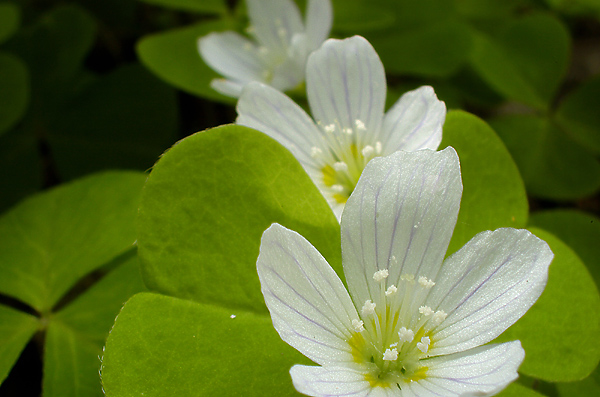
Wood
Sorrel
©
Bjørn Rørslett/NN
|
| The Wood Sorrel (Oxalis
acetosella) is a small-flowered spring species, and
getting close-ups of these delicate flowers while a good
depth-of-field is maintained is not an easy task for the
nature photographer. The 6.5 mm Canon lens mounted on my
D2H did the trick, though. |
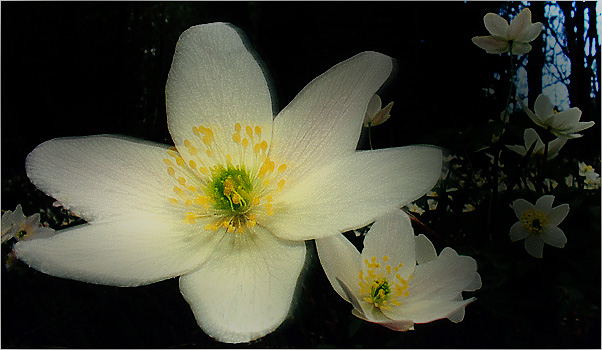
Wood
Anemones
©
Bjørn Rørslett/NN
|
| This shot of Wood Anemone (Anemone
nemorosa) was acquired using my F4 and the 24 mm
Nikkor as an intermediate lens. The floor of this wood
was quite dark, and in order to stop wind-induced
movement of these pretty flowers, a flash was put to its
intended use. |
Acknowledgements
I could never have accomplished
these conversions without the assistance of lenses given to me by
kind people. Thanks go to Paul Hofseth and Paul D. Wilson for
providing me with the 6.5 mm Canon and 10 mm Nikkor,
respectively. Ove Bergersen directed my attention to a Nikon
Multiphot photomacrographic camera with a complete array of
Macro-Nikkor lenses, including the 19 mm used here.
| Format Conversion: A
Project for Those Dreary, Wet Days You Rather Spend
Indoors |
|
| |





